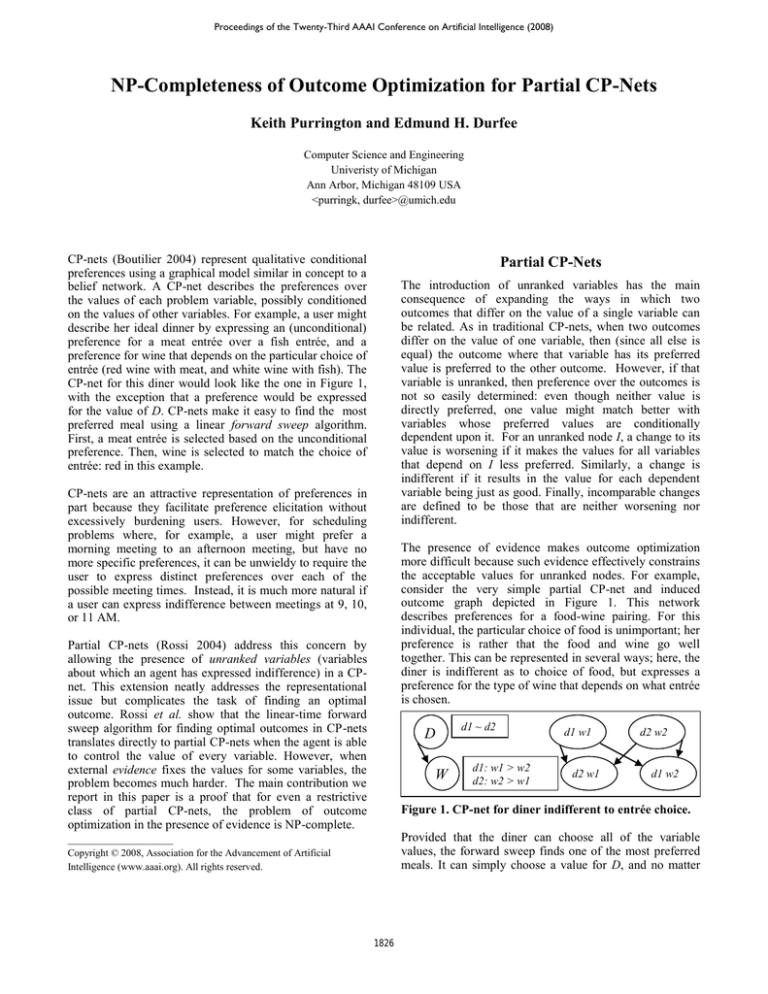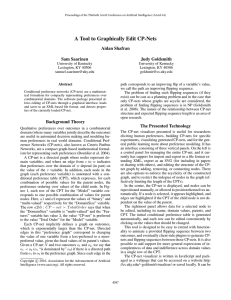
Proceedings of the Twenty-Third AAAI Conference on Artificial Intelligence (2008)
NP-Completeness of Outcome Optimization for Partial CP-Nets
Keith Purrington and Edmund H. Durfee
Computer Science and Engineering
Univeristy of Michigan
Ann Arbor, Michigan 48109 USA
<purringk, durfee>@umich.edu
CP-nets (Boutilier 2004) represent qualitative conditional
preferences using a graphical model similar in concept to a
belief network. A CP-net describes the preferences over
the values of each problem variable, possibly conditioned
on the values of other variables. For example, a user might
describe her ideal dinner by expressing an (unconditional)
preference for a meat entrée over a fish entrée, and a
preference for wine that depends on the particular choice of
entrée (red wine with meat, and white wine with fish). The
CP-net for this diner would look like the one in Figure 1,
with the exception that a preference would be expressed
for the value of D. CP-nets make it easy to find the most
preferred meal using a linear forward sweep algorithm.
First, a meat entrée is selected based on the unconditional
preference. Then, wine is selected to match the choice of
entrée: red in this example.
Partial CP-Nets
The introduction of unranked variables has the main
consequence of expanding the ways in which two
outcomes that differ on the value of a single variable can
be related. As in traditional CP-nets, when two outcomes
differ on the value of one variable, then (since all else is
equal) the outcome where that variable has its preferred
value is preferred to the other outcome. However, if that
variable is unranked, then preference over the outcomes is
not so easily determined: even though neither value is
directly preferred, one value might match better with
variables whose preferred values are conditionally
dependent upon it. For an unranked node I, a change to its
value is worsening if it makes the values for all variables
that depend on I less preferred. Similarly, a change is
indifferent if it results in the value for each dependent
variable being just as good. Finally, incomparable changes
are defined to be those that are neither worsening nor
indifferent.
CP-nets are an attractive representation of preferences in
part because they facilitate preference elicitation without
excessively burdening users. However, for scheduling
problems where, for example, a user might prefer a
morning meeting to an afternoon meeting, but have no
more specific preferences, it can be unwieldy to require the
user to express distinct preferences over each of the
possible meeting times. Instead, it is much more natural if
a user can express indifference between meetings at 9, 10,
or 11 AM.
The presence of evidence makes outcome optimization
more difficult because such evidence effectively constrains
the acceptable values for unranked nodes. For example,
consider the very simple partial CP-net and induced
outcome graph depicted in Figure 1. This network
describes preferences for a food-wine pairing. For this
individual, the particular choice of food is unimportant; her
preference is rather that the food and wine go well
together. This can be represented in several ways; here, the
diner is indifferent as to choice of food, but expresses a
preference for the type of wine that depends on what entrée
is chosen.
Partial CP-nets (Rossi 2004) address this concern by
allowing the presence of unranked variables (variables
about which an agent has expressed indifference) in a CPnet. This extension neatly addresses the representational
issue but complicates the task of finding an optimal
outcome. Rossi et al. show that the linear-time forward
sweep algorithm for finding optimal outcomes in CP-nets
translates directly to partial CP-nets when the agent is able
to control the value of every variable. However, when
external evidence fixes the values for some variables, the
problem becomes much harder. The main contribution we
report in this paper is a proof that for even a restrictive
class of partial CP-nets, the problem of outcome
optimization in the presence of evidence is NP-complete.
D
W
d1 ~ d2
d1: w1 > w2
d2: w2 > w1
d1 w1
d2 w1
d2 w2
d1 w2
Figure 1. CP-net for diner indifferent to entrée choice.
Provided that the diner can choose all of the variable
values, the forward sweep finds one of the most preferred
meals. It can simply choose a value for D, and no matter
_____________________
Copyright © 2008, Association for the Advancement of Artificial
Intelligence (www.aaai.org). All rights reserved.
1826
same procedure to create an evidence node for each 3SAT
clause completes the reduction.
the choice, the CP-table for W provides a value that
ensures a successful pairing. If, however, the restaurant is
out of white wine (fixing the value of W to be w2), a
simple forward sweep is no longer guaranteed to find the
optimal outcome. When the value of w2 is fixed, the diner
can still be maximally satisfied, but to do so with a forward
sweep requires making the right arbitrary choice of red
meat before discovering that the restaurant is out of white
wine. To avoid the need for omniscience, a general
optimization algorithm must allow for backtracking.
It is straightforward to show that the problem is also
contained in NP. A solution certificate can be produced by
nondeterministically choosing an assignment for the
unranked nodes. Then, this certificate can be checked to
see if it simultaneously satisfies the evidence nodes in
polynomial time via simple inspection of the CP-table for
each evidence node.
This small example can be solved with a backward sweep
that uses the evidence to determine the proper value for the
unranked variable. However, as the CP-net structure
becomes more complex, a backward sweep encounters the
same need for backtracking as needed by a forward sweep.
In fact, we show that even for a very restricted class of
problems, making assignments to the unranked nodes so as
to ensure that the value of each evidence node is preferred
is NP-complete.
Algorithmic Approximation
While evidence-constrained partial CP-net optimization is
hard in general, a backward sweep algorithm as discussed
in conjunction with the diner example remains optimal in
certain special cases, namely when each unranked node has
at most one path to an evidence node. In such networks, a
three-step algorithm finds optimal outcomes in polynomial
time. The three algorithmic steps consist of a forward
sweep to assign variables that are independent of the
unranked nodes, followed by a backward sweep that works
back from the evidence nodes to determine optimal settings
for the unranked nodes, and finally, an additional forward
sweep to assign the variables that are dependent on the
unranked nodes. In addition to its provable optimality on
problems with the special structure, when the algorithm is
applied to general problems, it greatly outperforms a
GSAT-style random-walk algorithm, finding slightly better
solutions, while operating many times faster. Details of the
algorithm and its empirical evaluation, as well as a more
fully detailed NP-completeness proof, are available from
the authors upon request.
NP-Completeness of Outcome Optimization
We summarize here our proof of the NP-completeness of
outcome optimization for a very specialized class of partial
CP-nets. We consider partial CP-nets with a bipartite graph
structure <I, E, D>, where I is a set of unranked nodes, E
is a set of evidence nodes, and D is a set of directed edges
from nodes in I to nodes in E. These restricted CP-nets
look like the one in Figure 2. Finally, we restrict the
variables in these specialized networks to be binary-valued.
I1
I2
E1
I3
E2
Acknowledgments
E3
The work reported in this paper was supported, in part, by
the National Science Foundation under grant IIS-0534280.
We would like to thank Jim Boerkoel and the anonymous
reviewers for valuable feedback on this work.
Figure 2. Network showing bipartite structure
We show hardness by reducing 3SAT to the problem of
finding the optimal outcome in such a graph, by mapping
3SAT clauses to evidence nodes. By carefully choosing the
parent nodes and the CP-tables for the evidence nodes, we
ensure that each evidence variable is satisfied IFF the
corresponding 3SAT clause is satisfied.
References
Boutilier, C., Brafman, R.I., Domshlak, C., Hoos, H.H.,
and Poole, D. 2003. CP-nets: A Tool for Representing and
Reasoning with Conditional Ceteris Paribus Preference
Statements. In Journal of Artificial Intelligence Research
(JAIR) 21 (2004), 135-191.
Consider a particular 3SAT clause, say (I1 OR I2 OR ~I3).
To translate this to our CP-net, we create an evidence node
E, with three parents I1, I2, and I3. To construct the CPtable for E, say that a value of e (rather than ~e) satisfies
the node. Then, because E has three binary-valued parents,
there are eight entries in its CP-table. We fill in the table so
that e is preferred to ~e in exactly the rows that correspond
to satisfying assignments to the SAT clause. For each
evidence node, seven of the eight possible parent
assignments will satisfy that evidence. In this case, only for
(~i1, ~i2, i3) do we set ~e preferable to e. Performing the
Rossi, F., Venable, K.B., and Walsh, T. mCP Nets:
Representing and Reasoning with Preferences of Multiple
Agents. In: Procs. of the 19th Conf. on Artificial
Intelligence, LNCS 749, AAAI Press (2004) 729-734
1827








